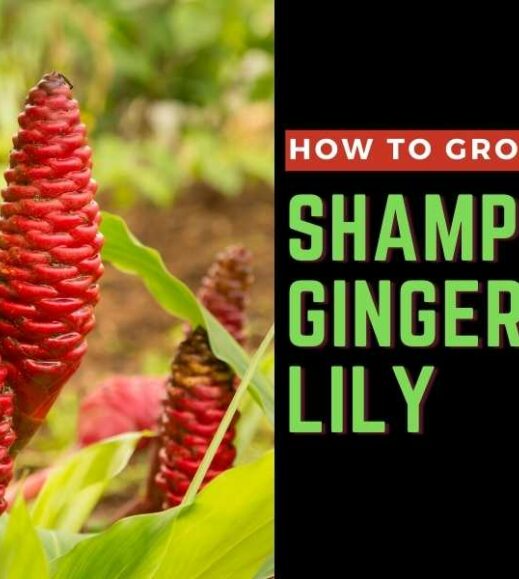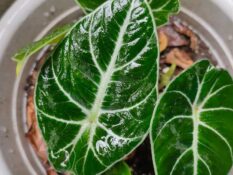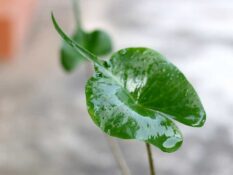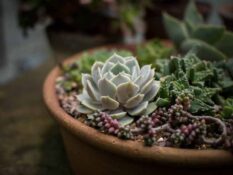The shampoo ginger lily also known as ginger shampoo plant, or 'Awapuhi Kuahiwi', is a native plant of Hawaii used for its therapeutic properties. The root and rhizome of the plant are both used to make medicine, and they have been traditionally used to treat various conditions, including skin infections, eczema, and dandruff.
The origins of shampoo ginger lily
The first shampoo gingers were brought to Hawaii by early Polynesian settlers who used the gel from the flowers to soften their hair. It was also used as a medicinal ointment for minor cuts and bruises and as a conditioner.
Where can I get shampoo ginger plant for sale?
Recent research has shown that the ginger shampoo plant has anti-inflammatory and antimicrobial properties, which could explain why it is so effective in treating these conditions. If you want this natural remedy, you can find shampoo ginger plants for sale online or at your local garden store.
How to use shampoo ginger lily?
The most common way to use shampoo ginger is to apply the gel from the flowers directly to wet hair. Many people prefer ginger shampoo plant because it is a natural alternative to store-bought conditioners that may contain harsh chemicals. Cut open the bloom and squeeze out the contents to extract the gel from the flower. No need to dilute the gel before applying it to your hair.
Look no further than shampoo ginger as a natural alternative to store-bought conditioners! Early Polynesian settlers used this plant for centuries as a conditioning agent. Try ginger shampoo plant next time you're at the grocery store! Your hair will thank you!
Skin benefits of shampoo ginger lily
Hawaiian Awapuhi, is the the key ingredient in several shampoo that is good for your skin! This tropical ginger has tissue-repairing properties, making it a powerful tool against dry skin.
If you have dry skin, using a product with Awapuhi, the shampoo ginger plant based cologne or body wash, would work wonders.
The shampoo ginger plant or the Awapuhi plant is also effective in soothing sunburns. If you've had a long day in the sun, slather our body butter onto your skin for the ultimate moisturizing experience and soothing relief.
3 amazing skin benefits of Awapuhi: Shampoo ginger lily
Hydration
Dry skin is no match for Awapuhi! This shampoo ginger plant has hydrating properties that help repair and restore your skin's moisture balance. If you suffer from dry skin, regular use of products containing Awapuhi will help keep your skin hydrated and healthy-looking all year long.
Tissue repair
If you are concerned about aging gracefully, using products containing Awapuhi or shampoo ginger plant regularly can help you accomplish that goal. The tissue-repairing properties of Awapuhi make it an excellent ingredient for reducing wrinkles and fine lines.
Soothing relief
In addition to its other benefits, Awapuhi is also effective in soothing sunburns. If you've had a long day in the sun, slathering your body butter onto your skin will provide instant relief from sunburn's pain and discomfort while also hydrating and repairing your skin.
This tropical ginger plant has amazing benefits for your skin. From hydration to tissue repair to soothing relief from sunburns, Awapuhi is a powerful tool against dry skin.
Propagating shampoo ginger lily plant
The rhizome is the best source of shampoo ginger plant propagation.
You won't find a more beautiful and fragrant plant than the shampoo ginger plant in your home. It is also called Zingiber zerumbet and is a member of the ginger family native to tropical Asia. The shampoo ginger plant was named for the oil from its flowers that is used in shampoos and soaps. The shampoo ginger plant is also known for its healing properties, and it has a pleasant fragrance.
What you must do if you want to propagate your shampoo ginger plant is as follows:
- Put on gloves and get ready with sterilized shears to begin propagating.
- Prepare sterilized shears and gloves before starting the propagation process.
- Cut the plant's rhizomes (roots; they resemble the ginger you buy at the store).
- A rhizome should have numerous buds when it is cut off.
- Give the cuts a few days to heal and calluses.
- Soak the roots in a jar of warm water for the entire night before planting.
- Keep the plant indoors in a cozy, safe space with plenty of light from indirect sources.
- Until the rhizomes develop, continuously water your plant and fertilize it every two weeks.
- You may move your shampoo ginger plant outside into a shaded part of your garden once it has blossomed.
- Maintain consistent watering and fertilization of your ginger plant to enjoy its beauty for many years!
If you follow the steps outlined above, you will soon grow your fragrant and beautiful shampoo ginger plants!
The best way to grow shampoo ginger from seed
The shampoo ginger plant is simple to grow and has several uses. How to cultivate shampoo ginger from seed is shown here. This native to Southeast Asia tropical plant will give your gardens a dash of exotic flair.
1. Take your seeds and soak them overnight in water. They should look swollen.
2. It is recommended to plant seeds in a tray filled with a nutrient-dense medium or seed-starting mixture.
3. Mix the seeds with the medium. If you plan to use more than one container, place your seeds 1-2 inches apart.
4. Position your seedling tray in a warm, humid environment.
5. Before transplanting, give the seed time to grow for 1-2 months after germinating.
A shampoo ginger plant can be grown easily from seed with little care. These beautiful and fragrant plants are perfect for anyone looking to add a touch of exotic to their garden and is very easy to maintain. Your shampoo ginger plant will be ready if you follow the steps above!
Shampoo ginger lily quick care guide
The shampoo ginger plant (Zingiber zerumbet) is a fragrant, flowering perennial from Southeast Asia, which is also naturalized in Hawaii. It's easy to see why this plant is such a popular ornamental choice; in addition to its beautiful flowers, the shampoo ginger plant also emits a pleasant, lemony fragrance. If you're thinking about adding a shampoo ginger plant to your home or garden, read on for everything you need to know about care and maintenance!
Sun and Temperature
If you live in an area where winter is cold, consider growing your shampoo ginger plant indoors. This plant thrives in full sunlight but can also tolerate partial shade. It prefers warm temperatures and won't survive a frost.
Water and Humidity
Water your shampoo ginger plant once a week and soak the roots thoroughly. These plants prefer high humidity levels, so consider misting them periodically or placing them on a pebble tray.
Soil
Shampoo ginger plants prefer rich, well-draining soil. If soil is overly sandy or clay-like, amend it with organic matter before planting.
Fertilizing
A balanced fertilizer should be applied to your shampoo ginger plant once a month during the growing season to prevent frost damage in the fall.
Pruning
When the foliage begins to yellow and die back in late summer or early fall, cut it back to the ground level to promote fresh new growth in the spring.
Propagation
Shampoo ginger plants can be propagated via division or by planting root cuttings. Division should be done in early spring, while root cuttings can be taken any time during the growing season.
With its fragrant flowers and pleasing lemon scent, it's no wonder the shampoo ginger plant is a popular choice for gardens and homes! These tropical beauties are relatively easy to care for, but there are a few things you'll need to keep in mind if you want your plants to thrive. Be sure to give them plenty of sun, water, and humidity, and fertilize them monthly during the growing season. With just a little TLC, your shampoo ginger plants will be healthy and happy for years to come!
Growing problems of shampoo ginger lily plant
Zingiber zerumbet thrives in moist soil, so water your plants regularly.
The plant also needs plenty of sunlight, so place it where it will get at least six hours of direct sunlight each day.
Zingiber zerumbet grows best in tropical climates, so if you live in a temperate climate, you may need to replant your plants every winter.
Common pests and diseases that affect shampoo ginger lily
The shampoo ginger plant is a hardy and fragrant species popular in many gardens. However, like all plants, shampoo ginger is susceptible to pests and disease. This blog post will discuss some of the most common shampoo ginger plant pests and diseases and how to deal with them.
One of the most common problems with the shampoo ginger plant is root rot or rhizome rot. This can often be caused by improper watering, leading to wet or waterlogged soil. To prevent root rot, it is important to check the plant regularly and water as needed. Removing any affected rhizomes and roots immediately is important if you suspect your plant has root rot.
Another common problem with the shampoo ginger plant is the presence of cardamom root grubs. These grubs are small white insects that feed on the plant's roots, causing damage and stunted growth. If you suspect that your plant has cardamom root grubs, it is important to inspect the roots carefully and remove any grubs that are present.
Spider mites are another pest that can affect the shampoo ginger plant. These tiny creatures suck the sap from leaves, causing them to turn yellow or brown. If you suspect that your plant has spider mites, it is important to inspect the leaves carefully and remove any mites that are present. Read our in-depth article on "9 ways to fight spider mites naturally".
Mealybugs are another type of pest that can affect the shampoo ginger plant. These small white insects feed on the plant's sap, causing damage and stunted growth. If you suspect your plant has mealybugs, it is important to inspect the leaves carefully and remove any present bugs.
The shampoo ginger plant is a hardy and fragrant species popular in many gardens. However, like all plants, shampoo ginger is susceptible to pests and disease. This blog post has discussed some of the most common shampoo ginger plant pests and diseases and how to deal with them. If you suspect your plant has any of these pests or diseases, it is important to take action immediately to prevent further damage.
In conclusion, known as shampoo ginger lily, the Awapuhi Kuahiwi plant is a beautiful and fragrant tropical plant found in Hawaii. Its leaves make shampoos, conditioners, soaps, and perfumes. Consider one of these unique products made from the Awapuhi Kuahiwi plant or the shampoo ginger lily plant if you are looking for a unique gift for someone you care about!

How to master gardening? Download these essential home and gardening ebooks today!
FAQs
Can you grow a shampoo ginger plant in a pot indoors?
Yes, you can grow Shampoo ginger plants indoors.
Is shampoo ginger plant edible?
Inflorescences, flowers, and rhizomes are edible. You can use the rhizomes (roots) like ginger.
Can the Pink Poinsettia and Ginger Shampoo Plant be Grown Together in the Same Garden?
Yes, the pink poinsettia plant beauty and ginger shampoo plant can be grown together in the same garden. Both plants have different growth requirements and complement each other well. The vibrant pink poinsettia plant beauty will add a pop of color, while the ginger shampoo plant offers unique fragrance and practical benefits.
Is the pinecone ginger invasive?
There is a possibility that the plant may be considered invasive outside of its native range unless it is provided with a limited amount of space.














